Dynamics of Compact Stellar Solutions Admitting Anisotropic Fluid: A Comparative Analysis of GR and Non-Conserved Rastall Gravity
Abstract
1. Introduction
2. Fundamentals of Rastall-Rainbow Gravity
3. Formulation of Exact Relativistic Solutions
3.1. Interior Model 1
3.2. Interior Model 2
3.3. Physical Motivation of Different Assumptions Used in Our Analysis
4. Graphical Analysis of Resulting Interior Solutions
4.1. Geometric Functions and Fluid Triplet
4.2. Gradient
4.3. Equation of State and Viability Check
- The NECs stipulate that an observer traveling along a null geodesic will measure the energy density in their local environment to be positive. The WECs mandate that the energy density, as observed by any timelike observer, must remain positive at all times. The SECs provide compelling evidence that the observer consistently detects a positive trace of the tidal tensor [83]. The DECs steadfastly affirm that, irrespective of the observer’s viewpoint, the local energy density is perceived as inherently non-negative, and the local energy flow vector is constrained to non-spacelike behavior [84]. Figure 5 shows that the DECs are satisfied for both models, implying that ordinary matter is present within their interiors.
4.4. Spherical Mass Function and Its Relying Factors
- Zero at the center, i.e., ,
- Positively increasing which implies , ∀ ,
- Continuous at boundary, i.e., (Schwarzschild mass).
4.5. Moment of Inertia
5. Stability Analysis
5.1. Sound Speed
5.2. Adiabatic Index
5.3. Comparative Analysis with General Relativity and Other Modified Theories
6. Conclusions
- The metric functions have been demonstrated to be well-defined, positive and regular throughout the internal region. Additionally, they displaye a constant value at the center and an increasing trend towards the outer edge, which allows for the construction of a dense compact models (Figure 1).
- The compact stellar object must demonstrate a positive energy density profile that gradually decreases from the densely concentrated center towards the surface. The radial pressure exhibits a consistently declining trend as one moves closer to the surface, as demonstrated and confirmed in Figure 2. The positive anisotropy observed in this Figure suggests that the anisotropic force acts in an outward direction, thereby contributing to the modeling of a stable configuration. Additionally, the regularity conditions have been verified (Figure 3).
- The EoS is a pivotal component in comprehensively evaluating the intrinsic characteristics of any stellar structure. This direct linear correlation between pressure and density, as illustrated in Figure 4, is essential for developing a profound understanding of these celestial bodies. Any viable physical model must strictly adhere to the prescribed bounds based on its pressures and density, which are claimed as energy conditions. We have carefully examined and determined that our models fully satisfy these requirements (Figure 5).
- Figure 6 shows that the mass function and compactness increase consistently as the radius grows, ultimately attaining their peak values at the surface. Additionally, the redshift reaches its maximum value at the surface and decreases towards the center. The rotational dynamics is also discussed in Figure 7.
- Our models successfully satisfied the causality and cracking conditions, as evidenced by both the individual sound speeds and their absolute difference being less than 1 (Figure 8). Additionally, the adiabatic index, as depicted in Figure 9, demonstrates that the tangential and radial components exceed the critical value of 4/3, thereby providing a robust verification of the stability of our proposed models.
- In Rastall gravity, the non-conservation of the energy-momentum tensor implies that matter and geometry are coupled non-minimally, allowing energy exchange between the matter fields and the gravitational field. In cosmological contexts, this non-conservation has been shown to mimic the effects of dark energy by driving accelerated expansion. In stellar cores, where densities and curvature are extremely high, this non-conservation can manifest as an effective modification to the pressure and density profiles, analogous to an additional energy component. For instance, the Rastall parameter influences the fluid variables in our models, leading to enhanced anisotropy and altered stability properties compared to GR. This can be interpreted as a dark energy-like effect, where the non-conserved energy-momentum contributes to a repulsive force, potentially stabilizing the star against gravitational collapse.
- When the parameter is set to zero, our findings converge with those of GR.
Author Contributions
Funding
Data Availability Statement
Conflicts of Interest
References
- Maurya, S.K.; Gupta, Y.K.; Ray, S.; Chowdhury, S.R. Spherically symmetric charged compact stars. Eur. Phys. J. C 2015, 75, 389. [Google Scholar] [CrossRef]
- Bhar, P.; Singh, K.N.; Manna, T. A new class of relativistic model of compact stars of embedding class I. Int. J. Mod. Phys. D 2017, 26, 1750090. [Google Scholar] [CrossRef]
- Rej, P.; Bhar, P. Charged strange star in f(R,T) gravity with linear equation of state. Astrophys. Space Sci. 2021, 366, 35. [Google Scholar] [CrossRef]
- Maurya, S.K.; Govender, M.; Kaur, S.; Nag, R. Isotropization of embedding Class I spacetime and anisotropic system generated by complexity factor in the framework of gravitational decoupling. Eur. Phys. J. C 2022, 82, 100. [Google Scholar] [CrossRef]
- Rao, V.U.M.; Sireesha, K.V.S.; Ch, D.; Rao, P. Perfect fluid cosmological models in a modified theory of gravity. Eur. Phys. J. Plus 2014, 129, 17. [Google Scholar] [CrossRef]
- Modak, B.; Sarkar, K.; Sanyal, A.K. Modified theory of gravity and the history of cosmic evolution. Astrophys. Space Sci. 2014, 353, 720. [Google Scholar] [CrossRef][Green Version]
- Azmat, H.; Zubair, M. An anisotropic version of Tolman VII solution in f(R,T) gravity via gravitational decoupling MGD approach. Eur. Phys. J. Plus 2021, 136, 112. [Google Scholar][Green Version]
- Nagpal, R.; Pacif, S.K.J. Chaotic solutions and black hole shadow in f(R) gravity. Eur. Phys. J. Plus 2021, 136, 875. [Google Scholar][Green Version]
- Azmat, H.; Zubair, M.; Ahmad, Z. Study of anisotropic and non-uniform gravastars by gravitational decoupling in f(R,T) gravity. Ann. Phys. 2022, 439, 168769. [Google Scholar][Green Version]
- Addazi, A.; Capozziello, S.; Odintsovgh, S. Chaotic solutions and black hole shadow in f(R) gravity. Phys. Lett. B 2021, 816, 136257. [Google Scholar] [CrossRef]
- Bowers, R.L.; Liang, E.P.T. Anisotropic spheres in general relativity. Astrophys. J. 1974, 188, 657. [Google Scholar] [CrossRef]
- Ivanov, B.V. Maximum bounds on the surface redshift of anisotropic stars. Phys. Rev. D 2002, 65, 104011. [Google Scholar] [CrossRef]
- Cosenza, M.; Herrera, L.; Esculpi, M.; Witten, L. Some models of anisotropic spheres in general relativity. J. Math. Phys. 1981, 22, 118. [Google Scholar] [CrossRef]
- Herrera, L.; Di Prisco, A.; Martin, J.; Ospino, J.; Santos, N.O.; Troconis, O. Spherically symmetric dissipative anisotropic fluids: A general study. Phys. Rev. D 2004, 69, 084026. [Google Scholar] [CrossRef]
- Herrera, L.; Barreto, W. Newtonian polytropes for anisotropic matter: General framework and applications. Phys. Rev. D 2013, 87, 087303. [Google Scholar] [CrossRef]
- Herrera, L.; Barreto, W. General relativistic polytropes for anisotropic matter: The general formalism and applications. Phys. Rev. D 2013, 88, 084022. [Google Scholar] [CrossRef]
- Errehymy, A.; Khedif, Y.; Daoud, M. Anisotropic compact stars via embedding approach in general relativity: New physical insights of stellar configurations. Eur. Phys. J. C 2021, 81, 266. [Google Scholar] [CrossRef]
- Rastall, P. Generalization of the Einstein theory. Phys. Rev. D 1972, 6, 3357. [Google Scholar] [CrossRef]
- Rastall, P. A theory of gravity. Can. J. Phys. 1976, 54, 66. [Google Scholar] [CrossRef]
- Gibbons, G.W.; Hawking, S.W. Cosmological event horizons, thermodynamics, and particle creation. Phys. Rev. D 1977, 15, 2738. [Google Scholar] [CrossRef]
- Parker, L. Quantized fields and particle creation in expanding universes. Phys. Rev. D 1971, 3, 346. [Google Scholar] [CrossRef]
- Ford, L.H. Gravitational particle creation and inflation. Phys. Rev. D 1987, 35, 2955. [Google Scholar] [CrossRef]
- Batista, C.E.M.; Daouda, M.H.; Fabris, J.C.; Piattella, O.F.; Rodrigues, D.C. Rastall cosmology and the Λ CDM model. Phys. Rev. D 2012, 85, 084008. [Google Scholar] [CrossRef]
- Pereira, S.H.; Bessa, C.H.G.; Lima, J.A.S. Quantized fields and gravitational particle creation in f(R) expanding universes. Phys. Lett. B 2010, 690, 103. [Google Scholar] [CrossRef]
- Calogero, S. A kinetic theory of diffusion in general relativity with cosmological scalar field. J. Cosmol. Astropart. Phys. 2011, 11, 016. [Google Scholar] [CrossRef]
- Calogero, S.; Velten, H. Cosmology with matter diffusion. J. Cosmol. Astropart. Phys. 2013, 11, 025. [Google Scholar] [CrossRef]
- Bezerra de Mello, E.R.; Fabris, J.C.; Hartmann, B. Abelian–Higgs strings in Rastall gravity. Class. Quantum Gravity 2015, 32, 085009. [Google Scholar] [CrossRef]
- Oliveira, A.M.; Velten, H.E.S.; Fabris, J.C.; Casarini, L. Neutron stars in Rastall gravity. Phys. Rev. D 2015, 92, 044020. [Google Scholar] [CrossRef]
- Batista, C.E.M.; Fabris, J.C.; Piattella, O.F.; Velasquez-Toribio, A.M. Observational constraints on Rastall’s cosmology. Eur. Phys. J. C 2013, 73, 2425. [Google Scholar] [CrossRef]
- Fabris, J.C.; Piattella, O.F.; Rodrigues, D.C.; Daouda, M.H. Rastall’s cosmology and its observational constraints. AIP Conf. Proc. 2015, 1647, 50. [Google Scholar]
- Capone, M.; Cardone, V.F.; Ruggiero, M.L. The possibility of an accelerating cosmology in Rastall’s theory. J. Phys. Conf. Ser. 2010, 222, 012012. [Google Scholar] [CrossRef]
- Fabris, J.C.; Piattella, O.F.; Rodrigues, D.C.; Batista, C.E.M.; Daouda, M.H. Rastall cosmology. Int. J. Mod. Phys. Conf. Ser. 2012, 18, 67. [Google Scholar]
- Campos, J.P.; Fabris, J.C.; Perez, R.; Piattella, O.F.; Velten, H. Does Chaplygin gas have salvation? Eur. Phys. J. C 2013, 73, 2357. [Google Scholar] [CrossRef]
- Fabris, J.C.; Daouda, M.H.; Piattella, O.F. Note on the evolution of the gravitational potential in Rastall scalar field theories. Phys. Lett. B 2012, 711, 232. [Google Scholar] [CrossRef]
- Moradpour, H. Thermodynamics of flat FLRW universe in Rastall theory. Phys. Lett. B 2016, 757, 187. [Google Scholar] [CrossRef]
- Al-Rawaf, A.S.; Taha, M.O. A resolution of the cosmological age puzzle. Phys. Lett. B 1996, 366, 69. [Google Scholar] [CrossRef]
- Al-Rawaf, A.S.; Taha, M.O. Cosmology of general relativity without energy-momentum conservation. Gen. Relativ. Gravit. 1996, 28, 935. [Google Scholar] [CrossRef]
- Saló, L.A.; Clough, K.; Figueras, P. Well-posedness of the four-derivative scalar-tensor theory of gravity in singularity avoiding coordinates. Phys. Rev. Lett. 2022, 129, 261104. [Google Scholar]
- Salako, I.G.; Houndjo, M.J.S.; Jawad, A. Generalized Mattig’s relation in Brans–Dicke–Rastall gravity. Int. J. Mod. Phys. D 2016, 25, 1650076. [Google Scholar]
- Heydarzade, Y.; Moradpour, H.; Darabi, F. Black hole solutions in Rastall theory. Can. J. Phys. 2017, 95, 1256. [Google Scholar] [CrossRef]
- Moradpour, H.; Sadeghnezhad, N.; Hendi, S.H. Traversable asymptotically flat wormholes in Rastall gravity. Can. J. Phys. 2017, 95, 1266. [Google Scholar] [CrossRef]
- Moradpour, H.; Salako, I.G. Thermodynamic analysis of the static spherically symmetric field equations in Rastall theory. Adv. High Energy Phys. 2016, 2016, 3492796. [Google Scholar] [CrossRef]
- Oliveira, A.M.; Velten, H.E.S.; Fabris, J.C.; Casarini, L. Nontrivial static, spherically symmetric vacuum solution in a nonconservative theory of gravity. Phys. Rev. D 2016, 93, 124020. [Google Scholar] [CrossRef]
- Jyothilakshmi, O.P.; Naik, L.J.; Sreekanth, V. Bose-Einstein condensate stars in combined Rastall-Rainbow gravity. Gen. Relativ. Gravit. 2024, 56, 141. [Google Scholar]
- Moradpour, H.; Heydarzade, Y.; Darabi, F.; Salako, I.G. A generalization to the Rastall theory and cosmic eras. Eur. Phys. J. C 2017, 77, 9. [Google Scholar] [CrossRef]
- Daly, R.A.; Djorgovski, S.G.; Freeman, K.A.; Mory, M.P.; O’dea, C.P.; Kharb, P.; Baum, S. Improved constraints on the acceleration history of the universe and the properties of the dark energy. Astrophys. J. 2008, 677, 1. [Google Scholar] [CrossRef]
- Komatsu, E.; Dunkley, J.; Nolta, M.R.; Bennett, C.L.; Gold, B.; Hinshaw, G.; Jarosik, N.; Larson, D.; Limon, M.; Page, L.E.A. et al. Five-year wilkinson microwave anisotropy probe* observations: Cosmological interpretation. Astrophys. J. Suppl. 2011, 192, 18. [Google Scholar] [CrossRef]
- Salvatelli, V.; Marchini, A.; Honorez, L.L.; Mena, O. New constraints on Coupled Dark Energy from the Planck satellite experiment. Phys. Rev. D 2013, 88, 023531. [Google Scholar] [CrossRef]
- Caliskan, A.; Mustafa, G.; Naseer, T.; Maurya, S.K.; Güdekli, E.; Murodov, S.; Atamurotov, F. Particle dynamics with trajectories and epicyclic oscillations around a piece-wise black hole immersed in dark matter. J. High Energy Astrophys. 2024, 44, 99–115. [Google Scholar] [CrossRef]
- Hassan, K.; Naseer, T.; Sharif, M. Applicability of modified Gauss–Bonnet gravity models on the existence of stellar structures. Chin. J. Phys. 2024, 91, 916–931. [Google Scholar] [CrossRef]
- Siza, B.; Andrade, J.; Santana, D.; Naseer, T. Anisotropic extension of the Kohler–Chao–Tikekar cosmological solution with like Wyman IIa complexity factor. Eur. Phys. J. C 2024, 84, 1203. [Google Scholar] [CrossRef]
- Yousaf, M.; Asad, H.; Almutairi, B.; Hasan, S.; Khan, A.S. Fuzzy black hole models in f(G) gravity. Phys. Scr. 2024, 99, 115270. [Google Scholar] [CrossRef]
- Murtaza, G.; Ditta, A.; Naseer, T.; Mustafa, G.; Maurya, S.K.; Ghaffar, A.; Javed, F. On the evaluation of accretion process near a quantum-improved charged black hole. J. High Energy Astrophys. 2024, 44, 279–289. [Google Scholar] [CrossRef]
- Naseer, T.; Mustafa, G. Physical validity of anisotropic models derived from isotropic fluid dynamics in f(R,T) theory: An implication of gravitational decoupling. Ann. Phys. 2025, 473, 169886. [Google Scholar] [CrossRef]
- Andrade, J.; Santana, D.; Naseer, T.; Londo, F. Ultra-compact anisotropic stellar model with vanishing complexity. Eur. Phys. J. C 2025, 85, 598. [Google Scholar] [CrossRef]
- Yousaf, M.; Asad, H.; Rehman, A. Dynamical evolution of self-gravitating compact fluid with hyperbolic corrections. Phys. Dark Universe 2025, 48, 101888. [Google Scholar] [CrossRef]
- Medina, S.S.C.; Andrade, J.; Santana, D.; Naseer, T. Effect of gravitational cracking on energy exchange in relativistic fluids: A first approach. Eur. Phys. J. C 2025, 85, 722. [Google Scholar] [CrossRef]
- Mustafa, G.; Maurya, S.K.; Naseer, T.; Cilli, A.; Güdekli, E.; Abd-Elmonem, A.; Alhubieshi, N. Particle motion and QPOs around Euler-Heisenberg black hole immersed in cold dark matter halo. Nucl. Phys. B 2025, 1012, 116812. [Google Scholar] [CrossRef]
- Yousaf, M. Impact of f(R) functions on the dynamical evolution of axially symmetric collapsing stars. Chin. J. Phys. 2025, 95, 1278–1302. [Google Scholar] [CrossRef]
- Rehman, A.; Naseer, T.; Dayanandan, B. Interpretation of complexity for spherically symmetric fluid composition within the context of modified gravity theory. Nucl. Phys. B 2025, 1013, 116852. [Google Scholar] [CrossRef]
- Mustafa, G.; Ditta, A.; Naseer, T.; Maurya, S.K.; Channuie, P.; Ibraheem, A.A.; Atamurotov, F. Circular motion, QPOs testing, emission energy and thermal fluctuations around a non-singular hairy Bardeen black hole. Eur. Phys. J. C 2025, 85, 575. [Google Scholar] [CrossRef]
- Ashraf, A.; Naseer, T.; Chaudhary, H.; Bouzenada, A.; Atamurotov, F.; Çil, B.; Güdekli, E. Observational constraints on QPOs with orbital motion around charged non-commutative Schwarzschild black hole surrounded by perfect fluid dark matter. Nucl. Phys. B 2025, 1014, 116873. [Google Scholar] [CrossRef]
- Dai, E.; Yousaf, M.; Javed, F.; Shrahili, M.; Zulqarnain, R.M. Imprints of monopole charge in Morris-Thorne type wormholes and energy conditions under the influence of higher dimensional gravity. Nucl. Phys. B 2025, 1018, 117017. [Google Scholar] [CrossRef]
- Rasheed, B.; Ditta, A.; Naseer, T.; Javed, F.; Mustafa, G. Analyzing the quantum corrected adS spherically symmetric black holes with phantom global monopoles for thermal properties. Int. J. Geom. Methods Mod. Phys. 2025, 22, 2450302. [Google Scholar] [CrossRef]
- Rehman, A.; Naseer, T.; Alessa, N.; Abdel-Aty, A.H. Orthogonal splitting of the Riemann curvature tensor and its implications in modeling compact stellar structures. Nucl. Phys. B 2025, 1015, 116897. [Google Scholar] [CrossRef]
- Ashraf, A.; Ditta, A.; Naseer, T.; Maurya, S.K.; Ray, S.; Channuie, P.; Atamurotov, F. Testing of QPOs, particle dynamics, emission energy and thermal fluctuation around a regular hairy black hole. Eur. Phys. J. C 2025, 85, 633. [Google Scholar] [CrossRef]
- Sharif, M.; Naseer, T.; Shadab, H. Physical existence of relativistic stellar models within the context of anisotropic matter distribution. Eur. Phys. J. C 2025, 85, 856. [Google Scholar] [CrossRef]
- Mota, C.E.; Santos, L.C.N.; Grams, G.; da Silva, F.M.; Menezes, D.P. Combined Rastall and rainbow theories of gravity with applications to neutron stars. Phys. Rev. D 2019, 100, 024043. [Google Scholar] [CrossRef]
- Magueijo, J.; Smolin, L. Gravity’s rainbow. Class. Quantum Grav. 2004, 21, 1725. [Google Scholar] [CrossRef]
- Mota, C.E.; Santos, L.C.N.; Grams, G.; da Silva, F.M. Anisotropic compact stars in Rastall–Rainbow gravity. Class. Quantum Grav. 2022, 39, 085008. [Google Scholar] [CrossRef]
- Debnath, U. Charged gravastars in Rastall-Rainbow gravity. Eur. Phys. J. Plus 2021, 136, 442. [Google Scholar] [CrossRef]
- Das, K.P.; Maity, S.; Saha, P.; Debnath, U. Charged anisotropic strange star in Rastall-Rainbow gravity. Mod. Phys. Lett. A 2022, 37, 2250201. [Google Scholar] [CrossRef]
- Baskey, L.; Ray, S.; Das, S.; Majumder, S.; Das, A. Anisotropic compact stellar solution in general relativity. Eur. Phys. J. C 2023, 83, 307. [Google Scholar] [CrossRef]
- Das, S.; Chakraborty, K.; Rahaman, F.; Majumder, S. Study of compact objects: A new analytical stellar model. Eur. Phys. J. C 2024, 84, 527. [Google Scholar] [CrossRef]
- Sharif, M.; Naseer, T. Charged stellar models possessing anisotropic interiors. Eur. Phys. J. Plus 2024, 139, 296. [Google Scholar] [CrossRef]
- Awad, A.; Ali, A.F.; Majumder, B. Nonsingular rainbow universes. J. Cosmol. Astropart. Phys. 2013, 1310, 052. [Google Scholar] [CrossRef]
- Khodadi, M.; Nozari, K.; Sepangi, H.R. More on the initial singularity problem in gravity’s rainbow cosmology. Gen. Relativ. Gravit. 2016, 48, 166. [Google Scholar] [CrossRef]
- Amelino-Camelia, G.; Ellis, J.; Mavromatos, N.E.; Nanopoulos, D.V.; Sarkar, S. Tests of quantum gravity from observations of γ-ray bursts. Nature 1998, 393, 763. [Google Scholar] [CrossRef]
- Güver, T.; Wroblewski, P.; Camarota, L.; Ozel, F. The mass and radius of the neutron star in 4U 1820-30. Astrophys. J. 2010, 719, 1807. [Google Scholar] [CrossRef]
- Gangopadhyay, T.; Ray, S.; Xiang-Dong, L.; Jishnu, D.; Mira, D. Strange star equation of state fits the refined mass measurement of 12 pulsars and predicts their radii. Mon. Not. R. Astron. Soc. 2013, 431, 3216. [Google Scholar] [CrossRef]
- Visser, M. Rastall gravity is equivalent to Einstein gravity. Phys. Lett. B 2018, 782, 83–86. [Google Scholar] [CrossRef]
- Abbas, G.; Shahzad, M.R. A new model of quintessence compact stars in the Rastall theory of gravity. Eur. Phys. J. A 2018, 54, 211. [Google Scholar] [CrossRef]
- Maurya, S.K.; Errehymy, A.; Singh, K.N.; Tello-Ortiz, F.; Daoud, M. Gravitational decoupling minimal geometric deformation model in modified f(R,T) gravity theory. Phys. Dark Universe 2020, 30, 100640. [Google Scholar] [CrossRef]
- Hawking, S.W.; Ellis, G.F.R. The Large Scale Structure of Space-Time; Cambridge University Press: Cambridge, UK, 1973. [Google Scholar]
- Buchdahl, H.A. General relativistic fluid spheres. Phys. Rev. 1959, 116, 1027. [Google Scholar] [CrossRef]
- Bejger, M.; Haensel, P. Moments of inertia for neutron and strange stars: Limits derived for the Crab pulsar. Astron. Astrophys. 2002, 396, 3. [Google Scholar] [CrossRef]
- Abreu, H.; Hernández, H.; Núñez, L.A. Sound speeds, cracking and the stability of self-gravitating anisotropic compact objects. Class. Quantum Grav. 2007, 24, 4631. [Google Scholar] [CrossRef]
- Herrera, L. Cracking of self-gravitating compact objects. Phys. Lett. A 1992, 165, 206. [Google Scholar] [CrossRef]
- Heintzmann, H.; Hillebrandt, W. Neutron stars with an anisotropic equation of state-mass, redshift and stability. Astron. Astrophys. 1975, 38, 51. [Google Scholar]
- Astashenok, A.V.; Capozziello, S.; Odintsov, S.D. Further stable neutron star models from f(R) gravity. J. Cosmol. Astropart. Phys. 2013, 12, 040. [Google Scholar] [CrossRef]
- Horbatsch, M.W.; Burgess, C.P. Cosmic black-hole hair growth and quasar OJ287. J. Cosmol. Astropart. Phys. 2012, 08, 027. [Google Scholar] [CrossRef]
- Doneva, D.D.; Yazadjiev, S.S.; Stergioulas, N.; Kokkotas, K.D. Rapidly rotating neutron stars in scalar-tensor theories of gravity. Phys. Rev. D 2013, 88, 084060. [Google Scholar] [CrossRef]
- Astashenok, A.V.; Capozziello, S.; Odintsov, S.D.; Oikonomou, V.K. Maximum baryon masses for static neutron stars in f(R) gravity. EuroPhys. Lett. 2021, 136, 59001. [Google Scholar] [CrossRef]
- Freire, P.C.C.; Wex, N.; Esposito-Farèse, G.; Verbiest, J.P.W.; Bailes, M.; Jacoby, B.A.; Kramer, M.; Stairs, I.H.; Antoniadis, J.; Janssen, G.H. The relativistic pulsar–white dwarf binary PSR J1738+ 0333–II. The most stringent test of scalar–tensor gravity. Mon. Not. R. Astron. Soc. 2012, 423, 3328–3343. [Google Scholar] [CrossRef]
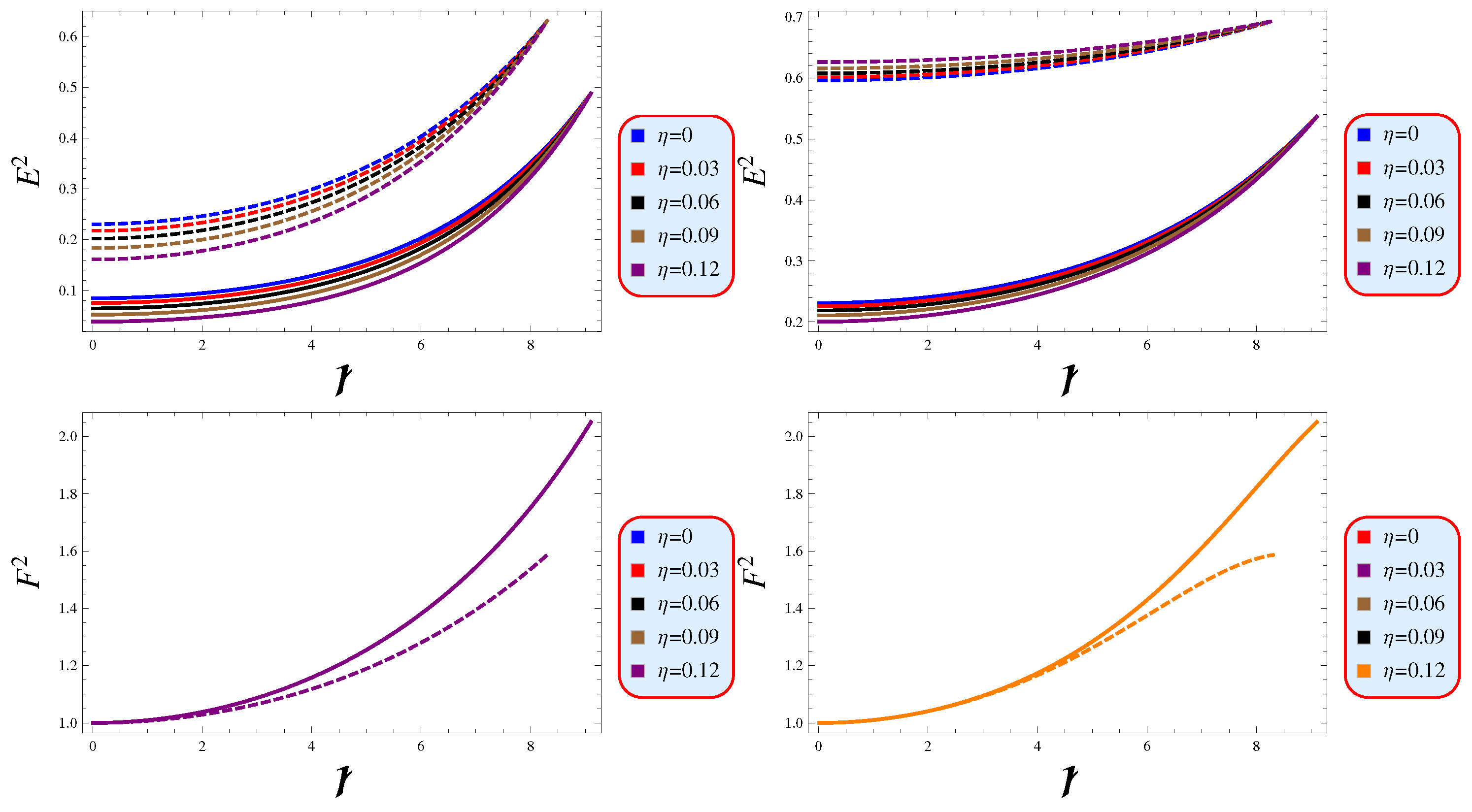
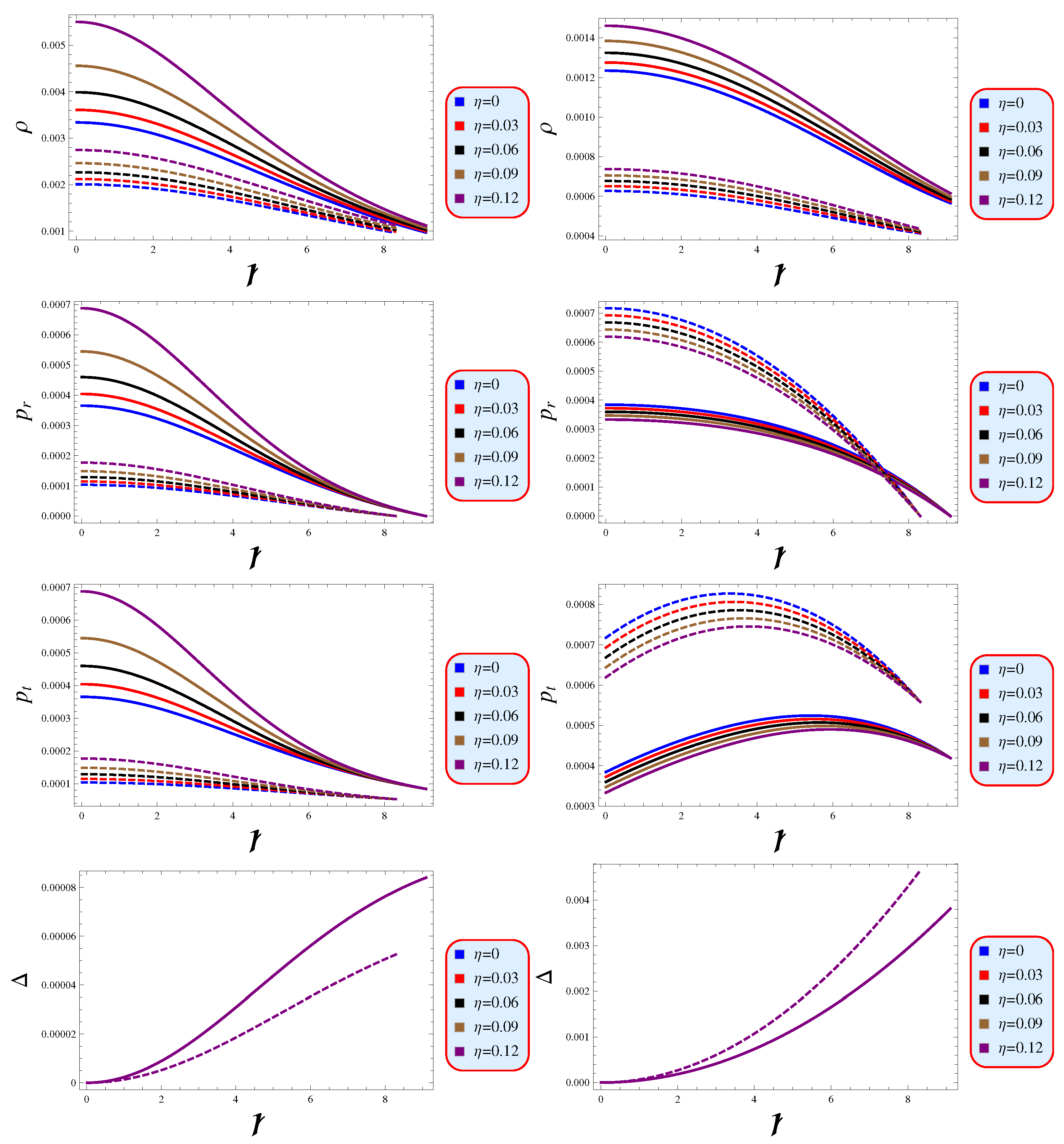
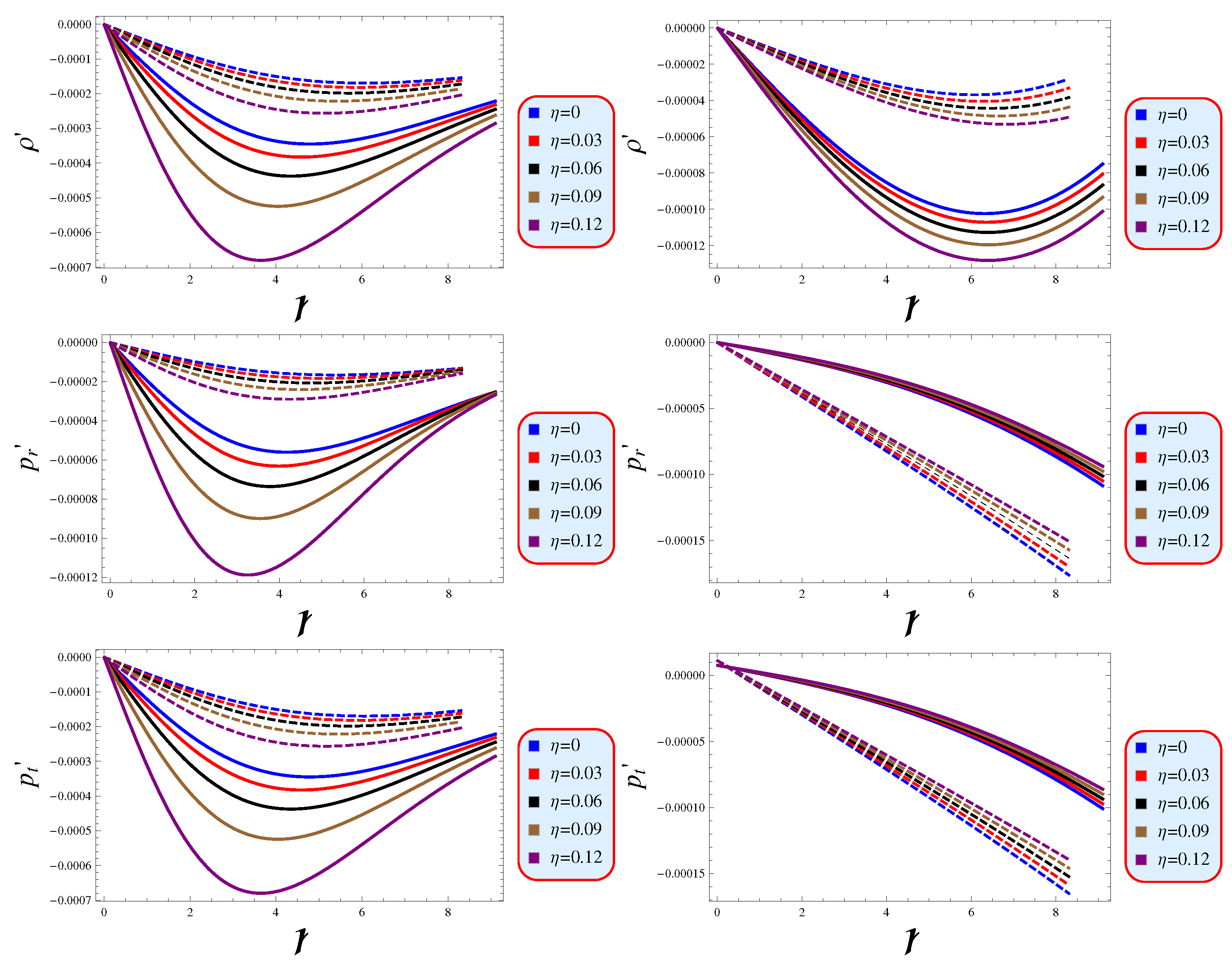
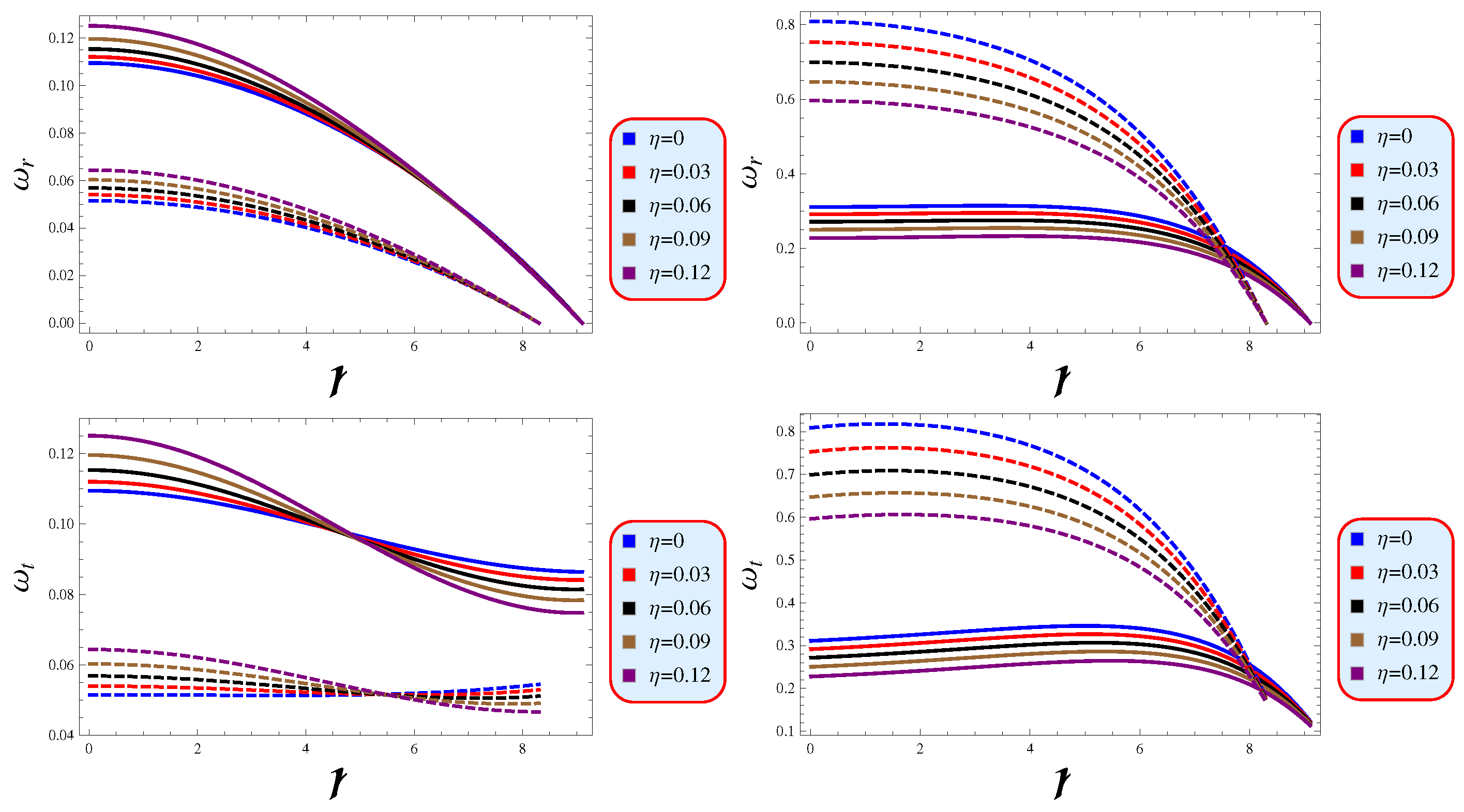
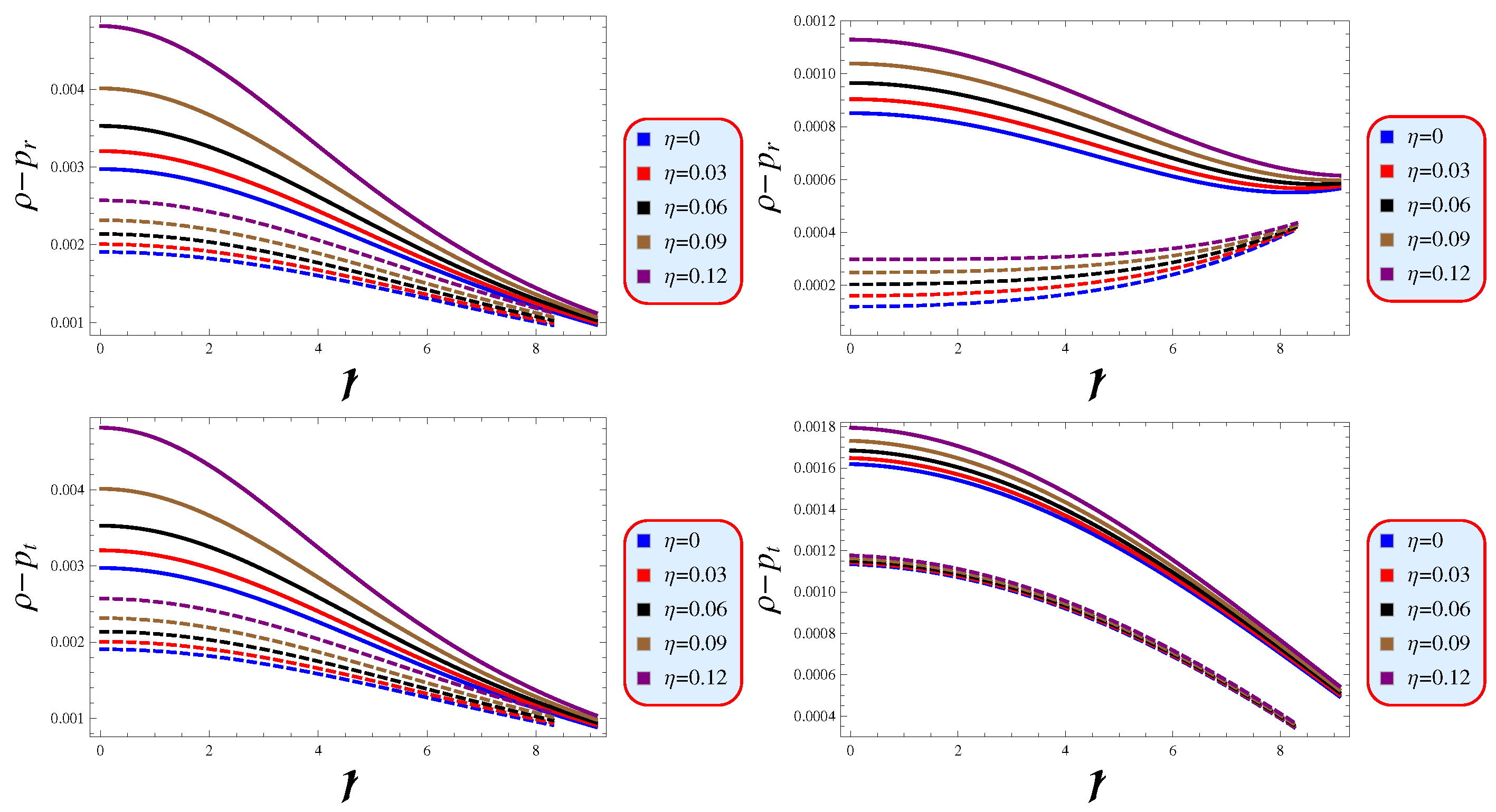
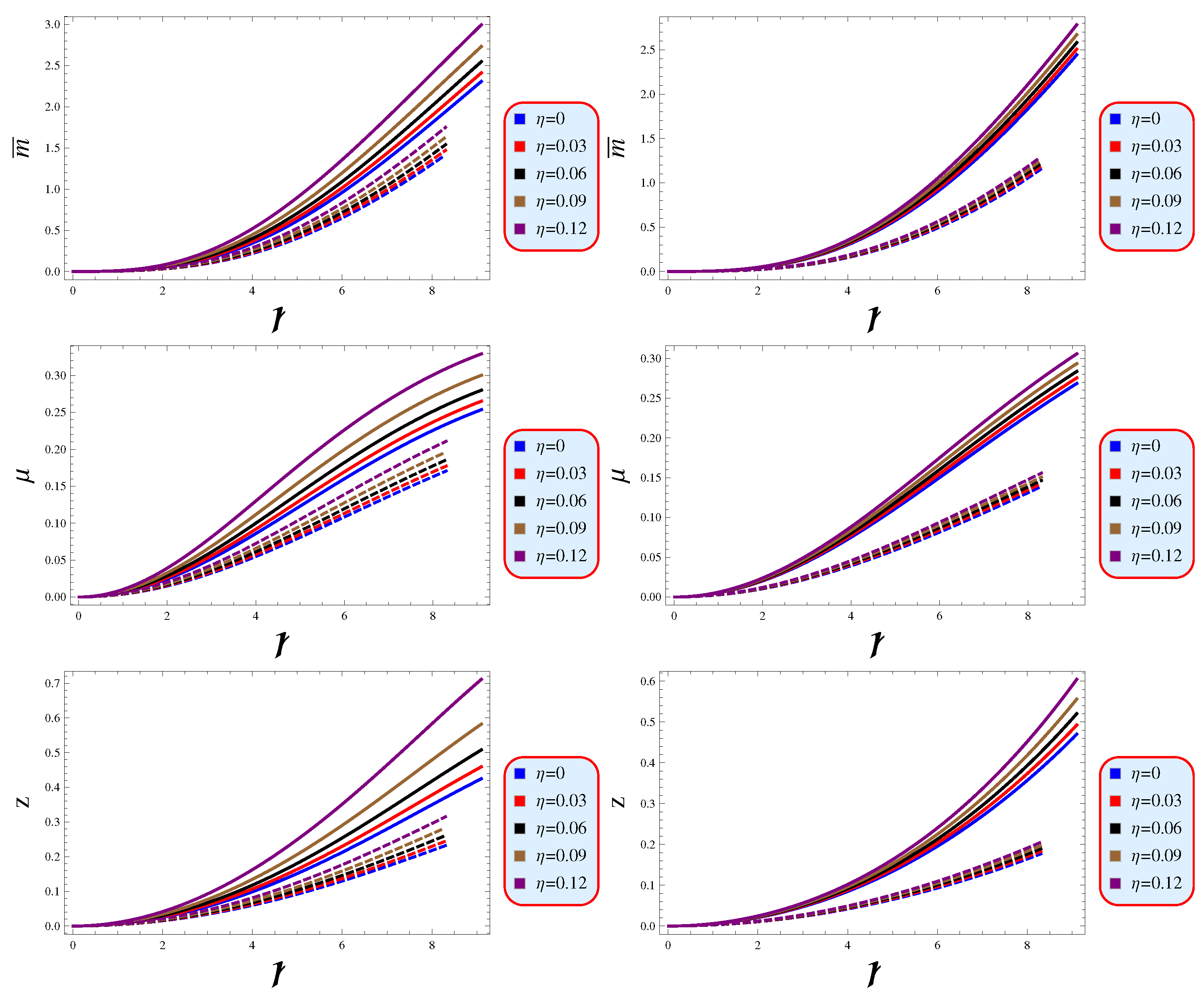

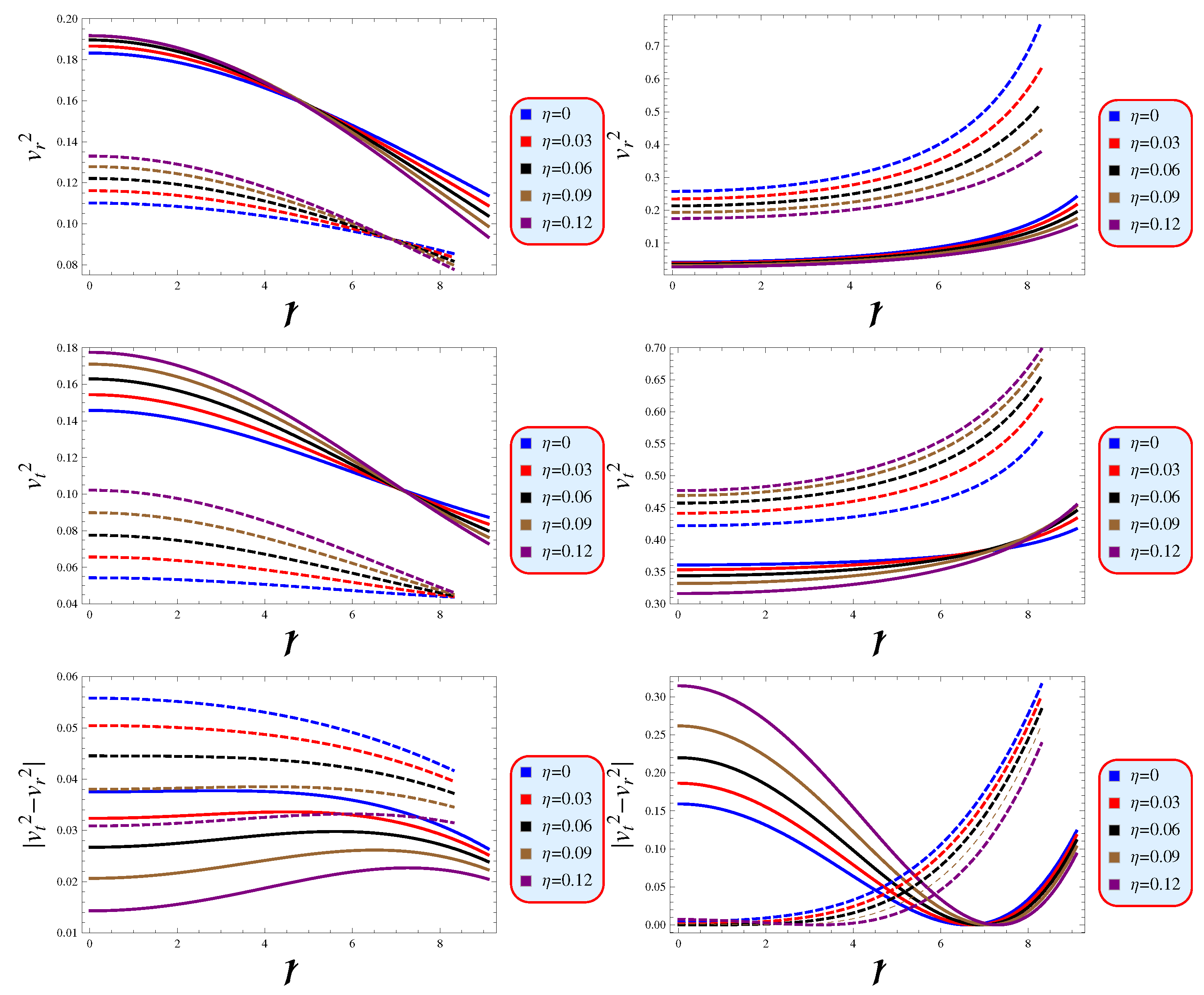
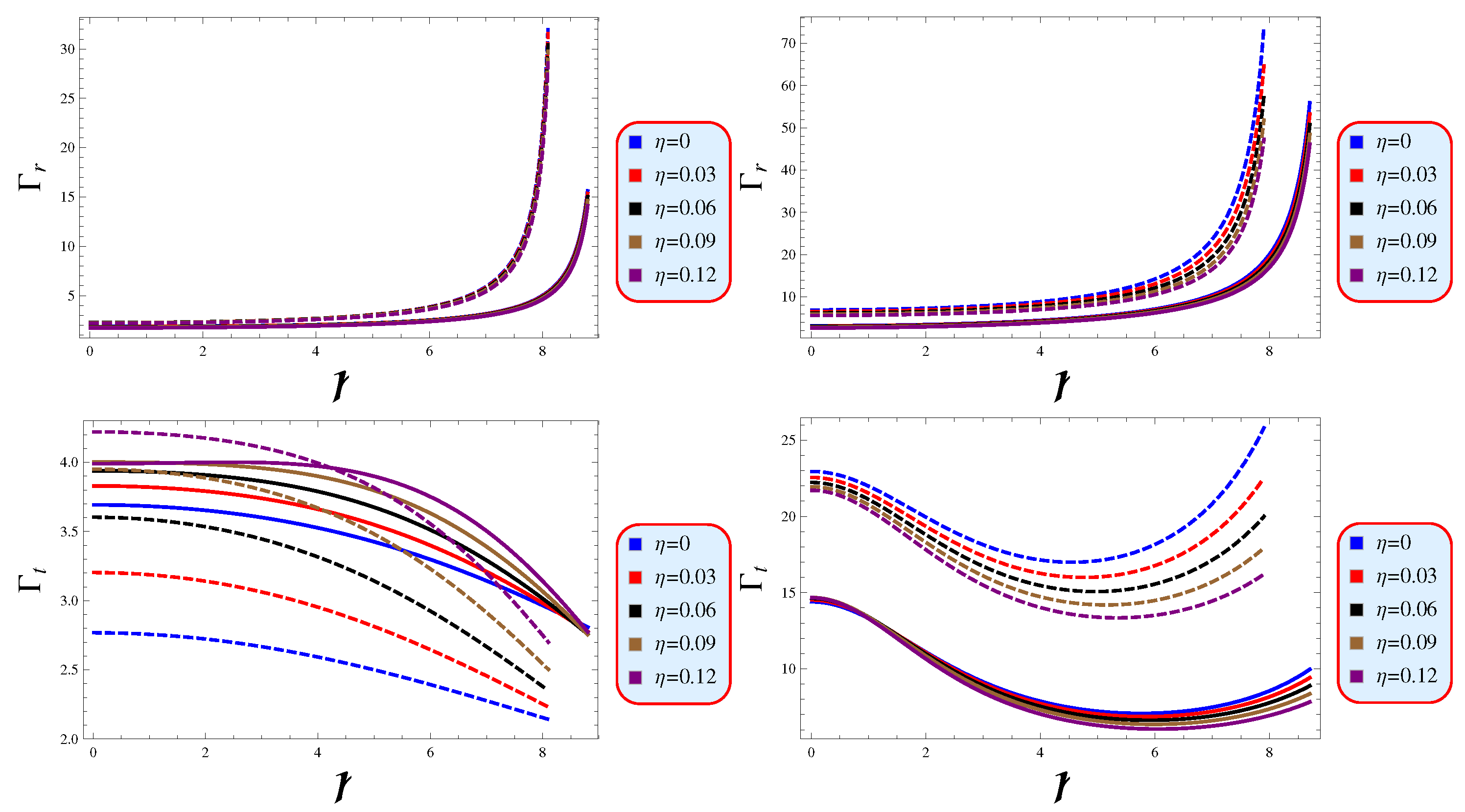
Disclaimer/Publisher’s Note: The statements, opinions and data contained in all publications are solely those of the individual author(s) and contributor(s) and not of MDPI and/or the editor(s). MDPI and/or the editor(s) disclaim responsibility for any injury to people or property resulting from any ideas, methods, instructions or products referred to in the content. |
© 2025 by the authors. Licensee MDPI, Basel, Switzerland. This article is an open access article distributed under the terms and conditions of the Creative Commons Attribution (CC BY) license (https://creativecommons.org/licenses/by/4.0/).
Share and Cite
Naseer, T.; Sharif, M.; Chand, F.; Dayanandan, B.; Elrashidi, A. Dynamics of Compact Stellar Solutions Admitting Anisotropic Fluid: A Comparative Analysis of GR and Non-Conserved Rastall Gravity. Galaxies 2025, 13, 106. https://doi.org/10.3390/galaxies13050106
Naseer T, Sharif M, Chand F, Dayanandan B, Elrashidi A. Dynamics of Compact Stellar Solutions Admitting Anisotropic Fluid: A Comparative Analysis of GR and Non-Conserved Rastall Gravity. Galaxies. 2025; 13(5):106. https://doi.org/10.3390/galaxies13050106
Chicago/Turabian StyleNaseer, Tayyab, Muhammad Sharif, Fatima Chand, Baiju Dayanandan, and Ali Elrashidi. 2025. "Dynamics of Compact Stellar Solutions Admitting Anisotropic Fluid: A Comparative Analysis of GR and Non-Conserved Rastall Gravity" Galaxies 13, no. 5: 106. https://doi.org/10.3390/galaxies13050106
APA StyleNaseer, T., Sharif, M., Chand, F., Dayanandan, B., & Elrashidi, A. (2025). Dynamics of Compact Stellar Solutions Admitting Anisotropic Fluid: A Comparative Analysis of GR and Non-Conserved Rastall Gravity. Galaxies, 13(5), 106. https://doi.org/10.3390/galaxies13050106







